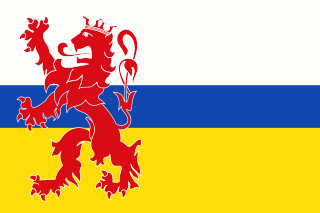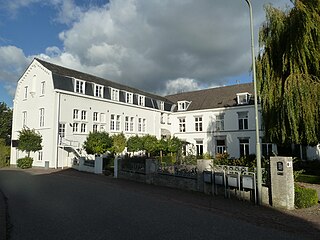
Limburg is the southernmost of the 12 provinces of the Netherlands. The province is bordered by the province of Gelderland to the north and by North Brabant to its west. Its long eastern boundary forms the international border with the state of North Rhine-Westphalia in Germany. To the west is the international border with the similarly named Belgian province of Limburg, part of which is delineated by the river Meuse. The Vaalserberg is on the extreme south-eastern point, marking the tripoint of the Netherlands, Germany and Belgium.

Limburg is a province in Belgium. It is the easternmost of the five Dutch-speaking provinces that together form the Region of Flanders, one of the three main political and cultural sub-divisions of modern Belgium.

Eijsden is a village situated in the very south of the European country the Netherlands. It is located in the southeastern part of the province of Limburg.

Roermond is a city, a municipality, and a diocese in the southeastern part of the Netherlands. Roermond is a historically important town on the lower Roer at the east bank of the river Meuse. In 1231 it received town rights. Roermond's town centre has become a designated conservation area.

Visé is a city and municipality of Wallonia, located on the river Meuse in the province of Liège, Belgium.

The Jeker is a river in Belgium and in the Netherlands. It is a left-bank tributary to the river Meuse. The source of the Jeker is near the village of Geer, in the Belgian province of Liège. The river is approximately 54 kilometres (34 mi) long, of which about 50 kilometres (31 mi) is in Belgium and 4 kilometres (2.5 mi) in the Netherlands, where it flows into the river Meuse at Maastricht (Netherlands).

Bemelen is a village in the Dutch province of Limburg. It is part of the municipality of Eijsden-Margraten, and lies about 5 km east of Maastricht.

Eckelrade is a village in the Dutch province of Limburg. It is part of the municipality of Eijsden-Margraten, and situated about 8 km southeast of the town of Maastricht.
Breust is a former village in the Dutch province of Limburg. It is located in the municipality of Eijsden-Margraten, and is now a neighbourhood of Eijsden.

Gronsveld is a village in the Dutch province of Limburg. It is part of the municipality of Eijsden-Margraten and situated southeast of the municipality of Maastricht, to which it is bordering.

Mesch is a village in the Dutch province of Limburg. It is located in the municipality of Eijsden-Margraten, quite near to the Netherlands' the southerly border with Belgium, on the other side of which the neighbouring village of Moelingen is situated. In its northwest, Mesch borders the larger village of Eijsden, whereas the city and municipality of Maastricht lies about 10 km farther to the north. The relatively small Voer river, which has its source in Belgium, passes through this village among other streams and waterways, before draining into the Meuse river at Eijsden. The Mergellandroute, a route often used by tourists and mapped out by the ANWB, also passes through Mesch.

Oost is a village in the south of the Netherlands. There it is situated near the "Maas" ("Meuse") river in the southwestern part of the province of Limburg.

Sint Geertruid is a village in the Dutch province of Limburg. It is located the municipality of Eijsden-Margraten.

The Voer is a small river in Belgium and the Netherlands. It is a right-bank tributary to the river Meuse. It has three (creek-) tributaries of its own: the Veurs, the Noor and the Beek.

Maastricht railway station is located in Maastricht in Limburg, Netherlands. It is the main railway station in Limburg's capital city. It is the southern terminus of the Alkmaar–Maastricht intercity service by NS. Additionally, Arriva and the Belgian NMBS serve the station with local trains.
Mosan Renaissance, also known as Maasland Renaissance, is a regional architectural style dating from the 16th and 17th centuries. The style is only remotely related to Renaissance architecture. The term should not be confused with Mosan art, which applies to Romanesque art and architecture during the Middle Ages in the region of the Meuse river valley.

Eijsden-Margraten (Dutch pronunciation: [ˌɛizdəˈmɑrɣraːtə ]; is a municipality situated in the very south of the Netherlands. There it is located in the southeastern part of the province of Limburg.

Moelingen is a village in the municipality of Voeren, which is part of the province of Limburg in Belgium.

The Belgium–Netherlands border separates Belgium and the Netherlands and is 450 km (280 mi) long.

The Noor or Langwater is a river in the Netherlands and Belgium. The Noor is a right-bank tributary to the river Voer, which later joins the Meuse. Rising in Eijsden-Margraten, in the Dutch province of Limburg, the Noor eventually drains in the river Voer in Voeren, in the Belgian province of Limburg.





















